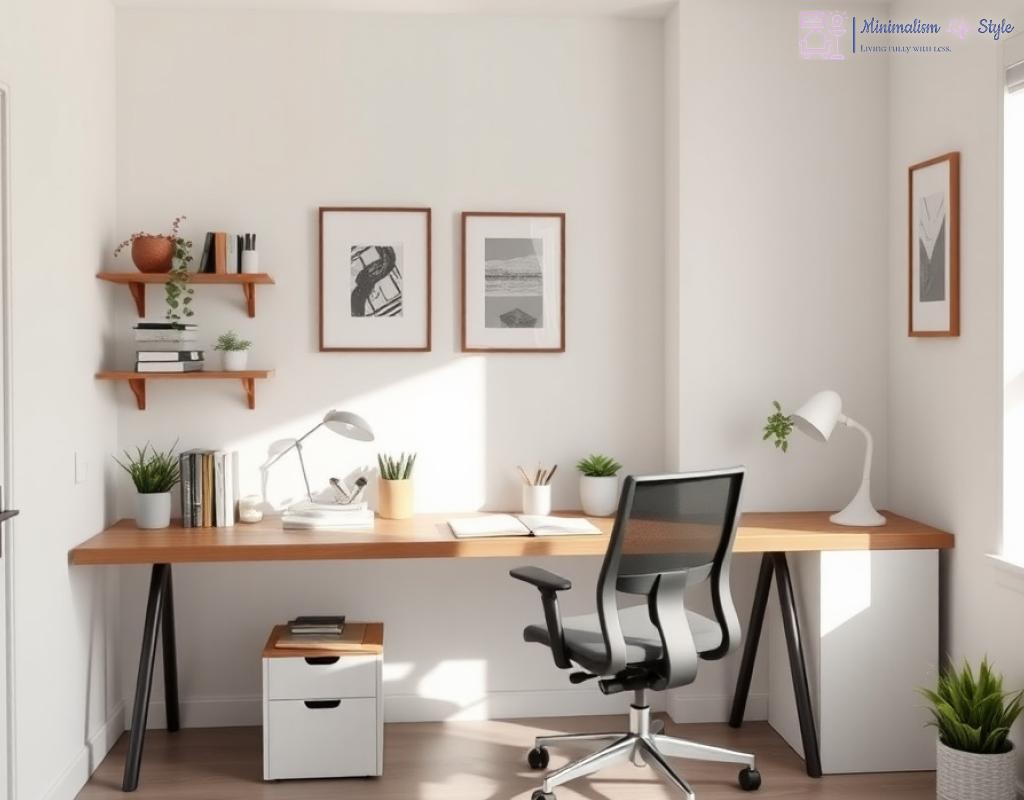Decluttering for Concentration

The Art of Minimalism in Study Spaces
In today’s fast-paced world, maintaining focus can feel like a daunting task, especially for families juggling multiple responsibilities. Creating a minimalist homework station can significantly enhance concentration, allowing students to immerse themselves fully in their studies. By simplifying the environment, distractions fade away, making room for productivity and creativity.
Steps to Achieve a Clutter-Free Homework Zone
Decluttering might seem overwhelming at first, but breaking it down into manageable steps can make the process more enjoyable and effective. Here’s how you can transform your space into an oasis of focus:
- Assess the Current Setup: Take a good look at the homework station. Identify items that are necessary versus those that are merely taking up space.
- Sort and Organize: Create designated areas for supplies, books, and materials. Use bins or containers to keep everything in its place.
- Limit Decorations: While personal touches are important, too many decorations can be distracting. Choose a few meaningful pieces that inspire rather than overwhelm.
- Implement a ‘One In, One Out’ Rule: To maintain a clutter-free environment, for every new item brought in, one must go out.
- Regularly Review the Space: Set a schedule to reassess the workspace monthly. This ensures that clutter does not accumulate over time.
Benefits of a Decluttered Study Space
Investing time in decluttering brings forth numerous benefits that extend beyond just a neat appearance. Here’s a quick comparison of the outcomes of a cluttered versus a decluttered study space:
| Aspect | Cluttered Space | Decluttered Space |
|---|---|---|
| Focus | Constant distractions | Enhanced concentration |
| Stress Levels | Increased anxiety | Promotes calmness |
| Time Management | Wasted time searching for items | Efficiency in finding materials |
| Creativity | Stifled by chaos | Encouraged by clarity |
In conclusion, creating a minimalist homework station by decluttering not only fosters a focused environment but also nurtures a more productive and peaceful mindset for students.
Essential Tools for Productive Learning

In the realm of education, having the right tools at your disposal can make a world of difference. A minimalist homework station isn’t just about reducing clutter; it’s about optimizing the environment with essential resources that foster effective learning. By strategically selecting tools, families can create a space that not only promotes focus but also enhances the overall learning experience.
Key Components of an Effective Study Toolkit
When setting up a minimalist homework station, it’s crucial to choose tools that align with the needs of the learners. Below is a list of essential items that can elevate a study space from merely functional to truly productive:
- Quality Writing Instruments: Invest in a few reliable pens, pencils, and highlighters. They should be comfortable to use and suitable for various writing tasks.
- Organized Notebooks: Use notebooks that are specifically designed for different subjects. This helps in categorizing notes and makes studying more efficient.
- Digital Tools: A tablet or laptop can be invaluable for research and assignments, but ensure it’s used purposefully to avoid distractions.
- Time Management Aids: Incorporate timers or planners to help students manage their time effectively during study sessions.
- Reference Materials: Keep essential textbooks and reference guides within arm’s reach, but limit them to what is necessary to avoid clutter.
Creating a Balanced Study Environment
The ambiance of a homework station can significantly influence productivity. Here are a few aspects to consider for a balanced learning atmosphere:
| Aspect | Cluttered Environment | Minimalist Environment |
|---|---|---|
| Lighting | Poorly lit, causing strain | Well-lit with natural light, enhancing focus |
| Noise Level | Distractions from surrounding noise | Quiet space, possibly with soft background music |
| Comfort | Uncomfortable seating leading to restlessness | Ergonomic furniture promoting sustained focus |
By addressing these elements, families can cultivate an environment that is not only conducive to learning but also enjoyable. The goal is to create a space that encourages students to engage deeply with their studies while minimizing distractions.
Designing a Distraction-Free Zone
In the quest for improved focus and productivity, the design of a homework station plays a pivotal role. A well-thought-out study environment not only minimizes external distractions but also fosters a sense of calm and clarity. By considering various design elements, families can create a distraction-free zone that enhances the learning experience for students. Let’s delve into the essential factors that contribute to a serene and effective study space.
Strategic Layout and Organization
The arrangement of furniture and materials can greatly impact concentration levels. When designing a distraction-free zone, consider the following:
- Ergonomic Furniture: Invest in comfortable, adjustable chairs and desks that encourage good posture and reduce physical strain.
- Defined Study Zones: Create specific areas for different activities, such as reading, writing, and digital work. This helps in mentally segmenting tasks.
- Accessibility: Ensure that all necessary supplies are easily reachable. This minimizes the urge to get up and wander around, which can lead to distractions.
Incorporating Calming Elements
Designing a distraction-free zone goes beyond merely organizing physical items; it also involves creating a soothing atmosphere. The following elements can help cultivate a tranquil environment:
- Color Palette: Opt for soft, neutral colors that promote relaxation and focus. Avoid bold, bright colors that may evoke energy and distraction.
- Natural Elements: Introduce plants or natural decor to enhance air quality and create a refreshing ambiance.
- Sound Management: Utilize rugs or wall hangings to absorb sound and reduce echoes, or consider white noise machines for a consistent auditory backdrop.
Establishing Routine and Boundaries
A distraction-free zone is not solely about the physical space; it also involves setting boundaries and routines that encourage focused study time. Here are some strategies:
- Scheduled Study Times: Designate specific hours for homework and ensure that all family members respect this time to minimize interruptions.
- Technology Breaks: While digital tools are essential, implement regular breaks from screens to maintain mental clarity.
- Clear Communication: Encourage family discussions about the importance of maintaining a quiet environment during study times.
By thoughtfully designing a distraction-free zone, families can foster an atmosphere that not only enhances academic performance but also nurtures a love for learning. Embracing these strategies can transform an ordinary homework station into a thriving educational haven.
Incorporating Family Involvement
Creating an effective minimalist homework station is not just about the physical space; it’s about fostering a collaborative environment that encourages family involvement. Engaging family members in the study process can enhance motivation, accountability, and overall success. When everyone contributes to the creation and maintenance of a focused study space, it transforms into a shared goal rather than an individual task.
Collaborative Space Design
Involving the entire family in the design of the homework station can lead to a more personalized and effective learning environment. Here are some strategies to consider:
- Family Brainstorming Sessions: Set aside time for everyone to share their ideas on how the homework station should look and function. This ensures that each member’s preferences are considered, making the space feel inclusive.
- Shared Responsibilities: Assign tasks to family members for maintaining the study area. Whether it’s organizing supplies or managing decorations, shared involvement fosters a sense of ownership.
- Feedback and Adjustments: Regularly discuss what is working and what isn’t in the study space. Encourage open communication to make adjustments that reflect the needs of the family.
Creating Study Routines Together
Establishing a structured study routine can significantly enhance focus and productivity. Here’s how to engage the family in developing effective study habits:
- Group Study Sessions: Schedule regular family study times where everyone engages in their tasks. This not only promotes accountability but also allows family members to support one another.
- Goal Setting: Work together to set academic goals. Whether it’s completing a project or improving grades, collective goals can increase motivation and provide a sense of achievement.
- Celebrating Achievements: Recognize and celebrate both individual and family accomplishments. This creates a positive reinforcement cycle that encourages continued effort.
Empowering Independence
While family involvement is crucial, it’s equally important to empower children to take ownership of their learning process. Here are some ways to balance family support with independence:
- Encouraging Self-Management: Teach children how to manage their own study schedules and resources. Provide guidance but allow them to take charge of their learning.
- Providing Resources: Ensure that learners have access to the tools they need to succeed independently. This includes not just physical tools but also digital resources for research and study.
- Reflective Practices: Encourage children to reflect on their learning experiences. This can be through journaling or discussions, helping them articulate what strategies work best for them.
Involving the family in creating a minimalist homework station not only enhances the study environment but also strengthens familial bonds. Embracing collective efforts in design, routine, and independence can lead to a more harmonious and productive learning experience.
Maintaining the Minimalist Space
Once a minimalist homework station has been established, the next challenge is maintaining this organized oasis of focus. A clutter-free environment not only promotes concentration but also fosters a sense of accomplishment and pride in the learning space. Consistency is key, and with a few strategic practices, families can ensure that their study zones remain inviting and productive.
In order to keep a minimalist homework station in top shape, integrating daily routines can work wonders. By establishing habits that prioritize organization, families can effortlessly maintain a tidy environment. Here are some engaging strategies to consider:
- End-of-Day Reset: Dedicate the last few minutes of study time each day to tidy up. Encourage students to put away supplies and clear their desks, making it a fun ritual.
- Weekly Check-ins: Set aside a specific day each week for a family check-in. Review the homework station’s organization together, identifying areas that might need a little extra attention.
- Involve Everyone: Make the maintenance of the study space a family affair. Assign different roles to each member, from organizing supplies to managing decorations, fostering a sense of shared responsibility.
While routines provide structure, it’s equally important to remain flexible and adaptable in maintaining the minimalist homework station. As students grow and their needs change, the study space should evolve too. Here are a few guiding principles to keep in mind for a continually relevant learning environment:
- Regular Evaluations: Schedule periodic evaluations of the study space. Are the tools still useful? Do the decorations inspire? This is an opportunity to refresh the environment as needed.
- Encourage Input: Involve students in the decision-making process. Allow them to express their preferences regarding the layout and tools, ensuring the space remains aligned with their evolving study habits.
- Adapt to New Challenges: As academic demands shift, be prepared to adjust the study area accordingly. This might include adding new resources or reconfiguring the layout for different subjects.
By embracing both routine and flexibility, families can maintain a minimalist homework station that remains conducive to focused learning, inspiring students to engage wholeheartedly in their academic journeys.




